A pujak (Worshipper) does individual preparation of purification through the medium of external coverings (of the body) such as the attire. The attire satisfies the pujak at a gross level and purifies his gross body. When we follow the Code of Conduct pertaining to the ritual of attire as mentioned in the Hindu Dharma, such as wearing sovale (A clean washed silk or cotton dhoti to be worn during Puja), uparna (A shawl or a small single cloth worn loosely over the shoulders), a nine-yard saree, ornaments, a garland of fragrant flowers in the hair, applying kumkum (Vermillion) or tilak (mark on the forehead using various objects), we move further on the path of sattvikta (Purity) through our gross body. Wearing appropriate clothing assists in attracting and absorbing the pure frequencies.
1. Clothes to be worn by men
‘Sovale is one that is tucked at five places. These five places are Pancha-mahabhutas – Pruthvi (Absolute Earth), Apa (Absolute Water), Tej (Absolute Fire), Vayu (Absolute Air) and Aksash (Absolute Water).’ – H.H. Sadgurusevak Sri Arunkaka.
The knot of the sovale is tied at the place of navel. Area of the navel itself is called the ‘Panchak-mandal’. The Panchaprans (Five vital energies) which are concentrated around the center of the navel region are activated due to the continuous pressure from the knot. The folds of the sovale are tucked at the same place where the knot connected with the Panchak-mandal is formed. These folds transmit the frequencies connected with the Universe and Panchamahabhutas in the atmosphere as per the need. Silk clothes of any colour, to be worn after praying and attracting Chaitanya (Divine consciousness) into it.
2. Nine yard saree worn by women
The nine-yard saree has layers of folds which makes it more capable of attracting, transmitting and holding Chaitanya as per the need, when compared to other clothes. This helps the Deity Principle to work at the vyashti (individual) and samashti (Society) level proportionate to the Bhav-urja (Energy of spiritual emotion) of the individual. The inner layer of a nine-yard saree holds on to the Chaitanya, the middle layer imbibes the Chaitanya while the outer layer does the function of transmitting the Chaitanya. Hence, wearing a nine-yard saree is more beneficial. The knot tied near the waist while wearing this saree stores the Chaitanya. The contact of Chaitanya activates the Pancha-pran situated around the Manipur-chakra and slowly it spreads all over the body.
3. Wearing of a shawl by women and uparna by men as upavastra
The spiritual level of an ordinary person is low and hence, he does not have the capacity to bear the energy frequencies emitted from the Deity. In fact, he can suffer from distress like headache, increased body heat, pain in the eyes. The energy frequencies emitted from the Deity are obstructed by the shawl and uparna, and later, these rapidly moving frequencies form a spherical protective sheath around the body. Thus, the pujak does not suffer from distress due to negative energies while performing Puja.
If the upavastra worn while performing Puja is made of silk, then it gets charged with the sattvik frequencies generated during the Puja and the result is then transferred to the Pranamaykosh (vital body sheath) and Manomaykosh (Mental sheath) as per the requirement.
4. Why should men place the uparna only on the
left shoulder during Puja and other religious rituals ?
‘Upa’ means proximity to Chaitanya. It also means ‘forever ready’. The Chandra-nadi is representative of the Tarak aspect and therefore, the upavastra is also called siddhavastra. The sagun (Materialised) aspect comes into readiness whenever required, but the nirgun (Non-materialised) is ever ready; hence, it can work without rest. In Puja, the right hand of the individual helps perform the task by becoming an assistant, while the cloth placed on the left shoulder gets charged with nirgun frequencies and assists the active sagun. Hence, the name upavastra (additional or assisting cloth). The flow of sattvik frequencies through the Chandranadi is peaceful and moderate in nature. Therefore, the cloth charged with such frequencies also represents the quality of nirgun. Hence, in relation to the ongoing task and a permanent stability, the upavastra is shown in a stable position on the left shoulder. With the help of the nirgun in the form of the cloth on the left shoulder, the Tej form frequencies of sagun Chaitanya in the right hand attain readiness and work in the ritual for its accomplishment. When the balance between the sagun and nirgun is established through the medium of the left and right channels, the possibility of the task getting fully accomplished is greater.
If the pujak wears a silk sovale, then it is not necessary to place an upavastra. This is because the capacity to imbibe Chaitanya is more in silk clothes than in cotton clothes. However, when the pujak wears washed (cotton) clothes it is beneficial to use silk upavastra. ‘Upa’ is the additional factor helpful in imbibing Chaitanya.
5. Science underlying the act of covering the head by a man or a woman
5 A. Wearing of a Topi (Cap) by men
Wearing a Topi makes it possible for the individual to use the energy frequencies concentrated in the hollow of the Topi for a prolonged period. This is because the inherent nature of a man is not Raja-predominant and as a result the Sattva-predominant frequencies cannot be dissipated in a short time at the level of the physical body. The medium of the Topi and the contact established due to concentration makes it possible for the individual to gradually dissipate these waves into the body.
5 B. Covering of the head with pallu (free end of her saree) by women
Since the inherent nature of the woman is Raja-predominant, she can emit specific Shakti (Divine Energy) frequencies into the atmosphere through the medium of the freely swinging end of pallu of her saree. Besides, she can also emit this Shakti in the body by activating the Raja component. The woman is thus a simulator and spreads the Shakti Principle into the atmosphere through the medium of her saree. The indigenously Raja-predominant and inspiration-imparting woman through the medium of her pallu gives Shakti Principle to the entire atmosphere.
6. Colour of clothes for the men and women
performing the Puja and those to be worn by the priest
The capacity of a pujak to imbibe Chaitanya is very poor in today’s times, when compared to the previous Yugs (Eras); hence whenever possible, the pujak should wear colour clothes while getting ready for the Puja. The colour clothes easily imbibe God’s frequencies on the strength of the colour particles, which have the ability to attract the Principles. This helps the pujak imbibe more Chaitanya in a lesser time and easily. A pujak with a spiritual level above 50% can wear white clothes.
It is beneficial for the priest to wear white clothes. White colour has equal capability of absorbing and emitting Chaitanya, thus reducing the Raja-Tama in the atmosphere. White garments have the capability of improving the Sattva component in the atmosphere making it conducive for the performance of the Puja.

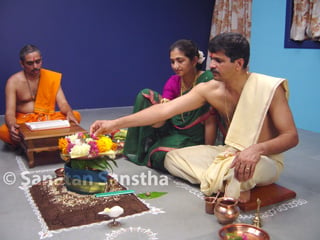 What are the benefits obtained from Puja preparations?
What are the benefits obtained from Puja preparations?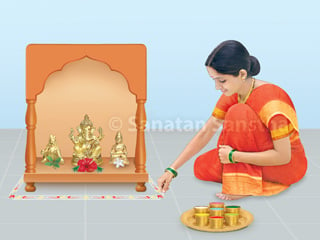 Importance of drawing Rangoli as a part of Puja preparations
Importance of drawing Rangoli as a part of Puja preparations Sounding of a conch at the commencement of a puja
Sounding of a conch at the commencement of a puja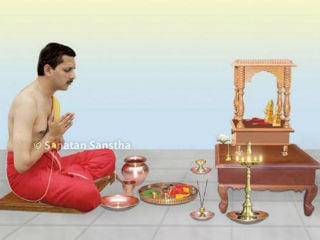 Why are kalash, conch, bell and lamp worshipped before puja ?
Why are kalash, conch, bell and lamp worshipped before puja ?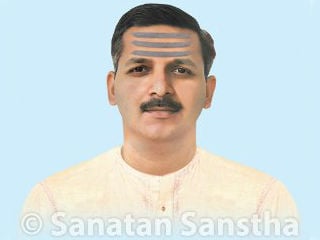 Importance of applying tilak or bhasma by the pujak while performing Puja
Importance of applying tilak or bhasma by the pujak while performing Puja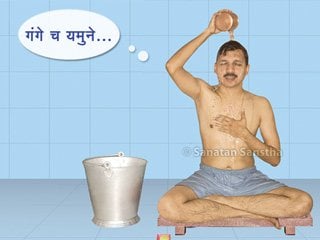 Why should we perform Puja immediately after a bath?
Why should we perform Puja immediately after a bath?